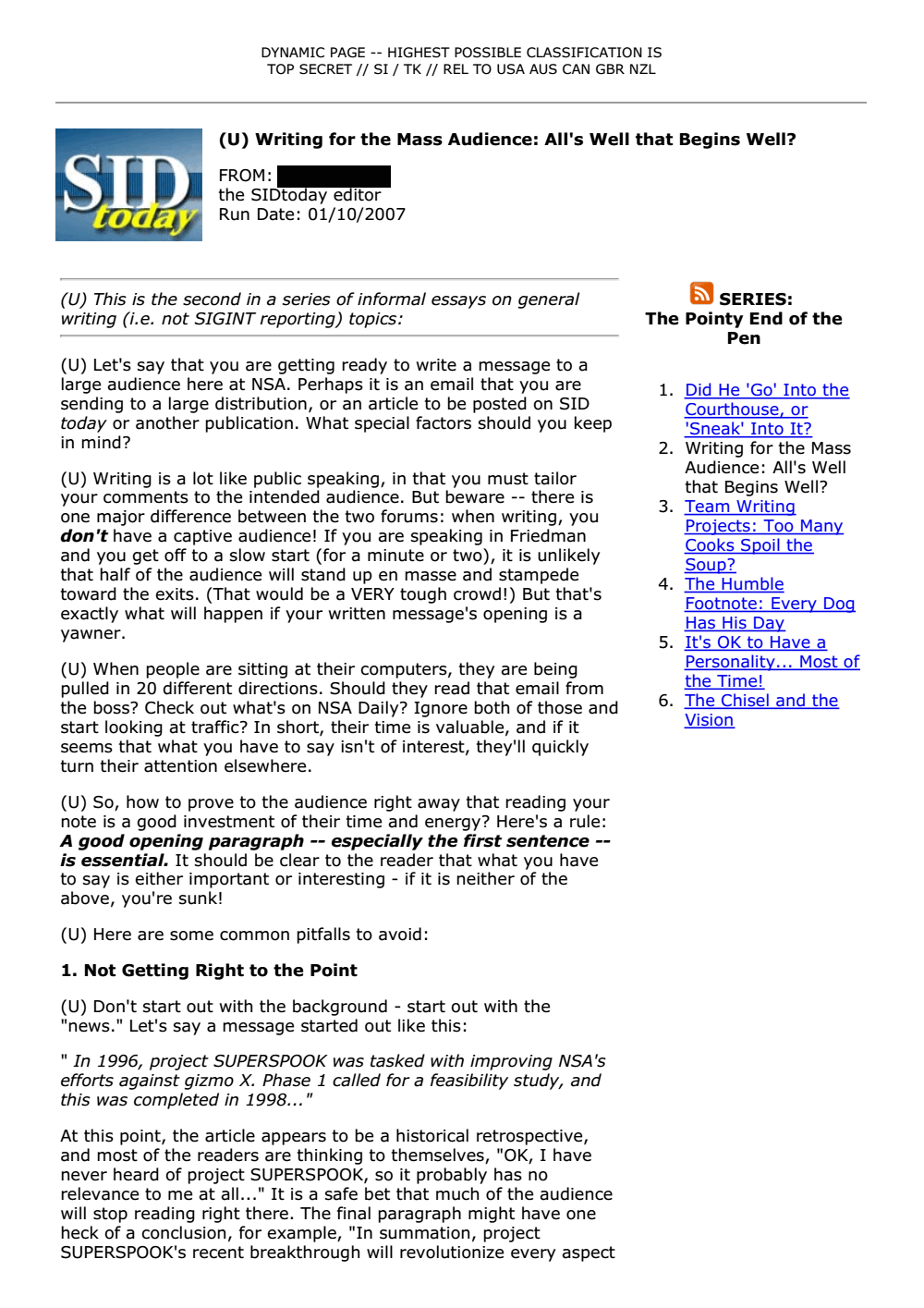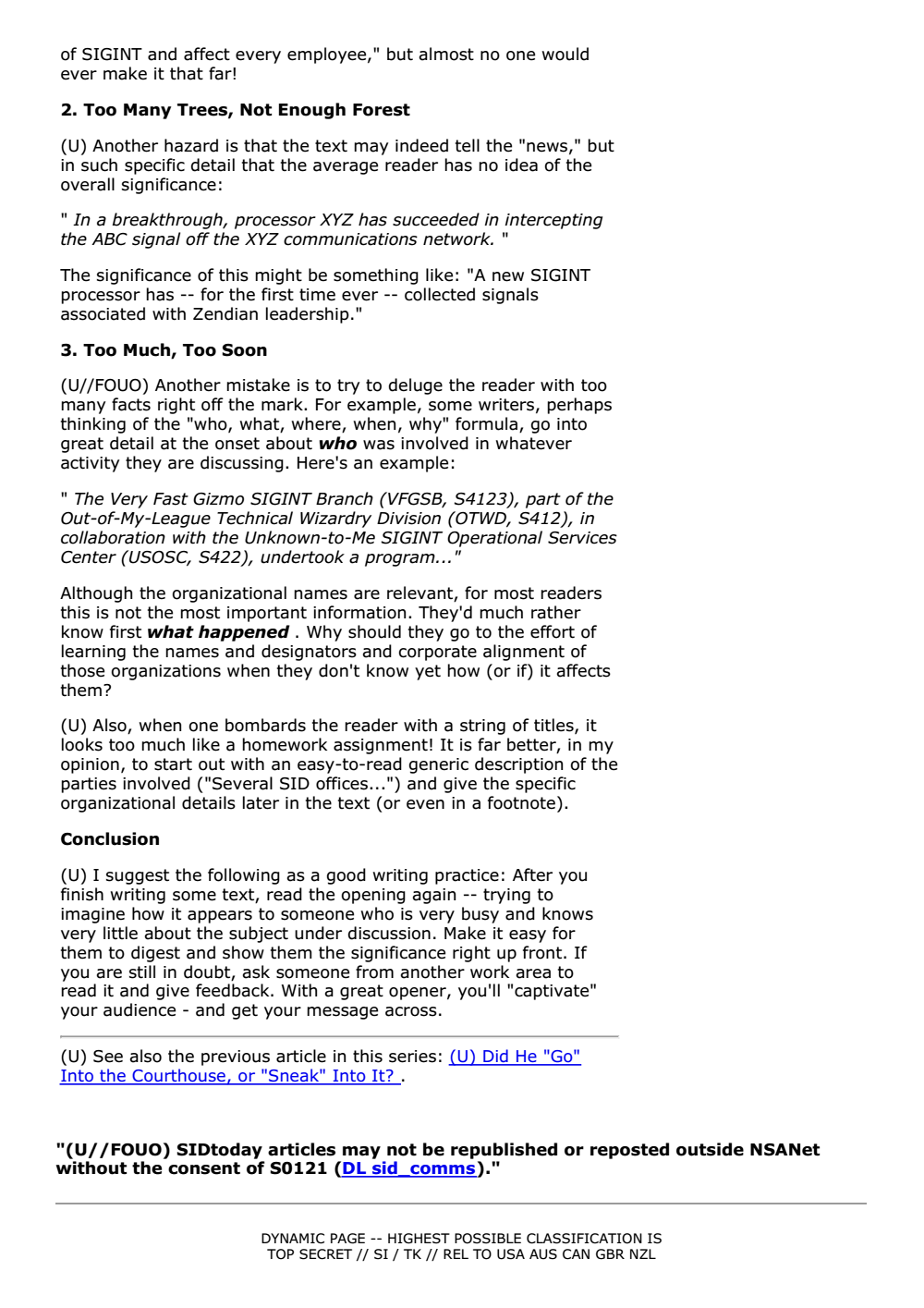
DYNAMIC PAGE -- HIGHEST POSSIBLE CLASSIFICATION IS
TOP SECRET // SI / TK // REL TO USA AUS CAN GBR NZL
(U) Writing for the Mass Audience: All's Well that Begins Well?
FROM:
the SIDtoday editor
Run Date: 01/10/2007
(U) This is the second in a series of informal essays on general
writing (i.e. not SIGINT reporting) topics:
(U) Let's say that you are getting ready to write a message to a
large audience here at NSA. Perhaps it is an email that you are
sending to a large distribution, or an article to be posted on SID
today or another publication. What special factors should you keep
in mind?
(U) Writing is a lot like public speaking, in that you must tailor
your comments to the intended audience. But beware -- there is
one major difference between the two forums: when writing, you
don't have a captive audience! If you are speaking in Friedman
and you get off to a slow start (for a minute or two), it is unlikely
that half of the audience will stand up en masse and stampede
toward the exits. (That would be a VERY tough crowd!) But that's
exactly what will happen if your written message's opening is a
yawner.
(U) When people are sitting at their computers, they are being
pulled in 20 different directions. Should they read that email from
the boss? Check out what's on NSA Daily? Ignore both of those and
start looking at traffic? In short, their time is valuable, and if it
seems that what you have to say isn't of interest, they'll quickly
turn their attention elsewhere.
(U) So, how to prove to the audience right away that reading your
note is a good investment of their time and energy? Here's a rule:
A good opening paragraph -- especially the first sentence -is essential. It should be clear to the reader that what you have
to say is either important or interesting - if it is neither of the
above, you're sunk!
(U) Here are some common pitfalls to avoid:
1. Not Getting Right to the Point
(U) Don't start out with the background - start out with the
"news." Let's say a message started out like this:
" In 1996, project SUPERSPOOK was tasked with improving NSA's
efforts against gizmo X. Phase 1 called for a feasibility study, and
this was completed in 1998..."
At this point, the article appears to be a historical retrospective,
and most of the readers are thinking to themselves, "OK, I have
never heard of project SUPERSPOOK, so it probably has no
relevance to me at all..." It is a safe bet that much of the audience
will stop reading right there. The final paragraph might have one
heck of a conclusion, for example, "In summation, project
SUPERSPOOK's recent breakthrough will revolutionize every aspect
SERIES:
The Pointy End of the
Pen
1. Did He 'Go' Into the
Courthouse, or
'Sneak' Into It?
2. Writing for the Mass
Audience: All's Well
that Begins Well?
3. Team Writing
Projects: Too Many
Cooks Spoil the
Soup?
4. The Humble
Footnote: Every Dog
Has His Day
5. It's OK to Have a
Personality... Most of
the Time!
6. The Chisel and the
Vision

of SIGINT and affect every employee," but almost no one would
ever make it that far!
2. Too Many Trees, Not Enough Forest
(U) Another hazard is that the text may indeed tell the "news," but
in such specific detail that the average reader has no idea of the
overall significance:
" In a breakthrough, processor XYZ has succeeded in intercepting
the ABC signal off the XYZ communications network. "
The significance of this might be something like: "A new SIGINT
processor has -- for the first time ever -- collected signals
associated with Zendian leadership."
3. Too Much, Too Soon
(U//FOUO) Another mistake is to try to deluge the reader with too
many facts right off the mark. For example, some writers, perhaps
thinking of the "who, what, where, when, why" formula, go into
great detail at the onset about who was involved in whatever
activity they are discussing. Here's an example:
" The Very Fast Gizmo SIGINT Branch (VFGSB, S4123), part of the
Out-of-My-League Technical Wizardry Division (OTWD, S412), in
collaboration with the Unknown-to-Me SIGINT Operational Services
Center (USOSC, S422), undertook a program..."
Although the organizational names are relevant, for most readers
this is not the most important information. They'd much rather
know first what happened . Why should they go to the effort of
learning the names and designators and corporate alignment of
those organizations when they don't know yet how (or if) it affects
them?
(U) Also, when one bombards the reader with a string of titles, it
looks too much like a homework assignment! It is far better, in my
opinion, to start out with an easy-to-read generic description of the
parties involved ("Several SID offices...") and give the specific
organizational details later in the text (or even in a footnote).
Conclusion
(U) I suggest the following as a good writing practice: After you
finish writing some text, read the opening again -- trying to
imagine how it appears to someone who is very busy and knows
very little about the subject under discussion. Make it easy for
them to digest and show them the significance right up front. If
you are still in doubt, ask someone from another work area to
read it and give feedback. With a great opener, you'll "captivate"
your audience - and get your message across.
(U) See also the previous article in this series: (U) Did He "Go"
Into the Courthouse, or "Sneak" Into It? .
"(U//FOUO) SIDtoday articles may not be republished or reposted outside NSANet
without the consent of S0121 (DL sid_comms)."
DYNAMIC PAGE -- HIGHEST POSSIBLE CLASSIFICATION IS
TOP SECRET // SI / TK // REL TO USA AUS CAN GBR NZL

DERIVED FROM: 1-52, DATED 08 JAN 2007 DECLASSIFY ON: 20320108